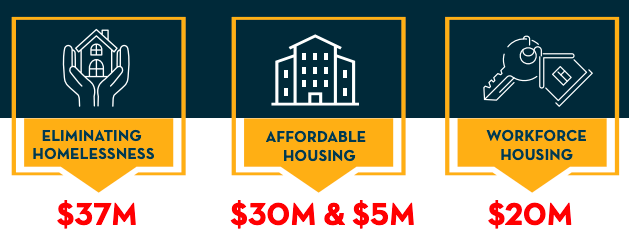Mayor Muriel Bowser’s proposed Fiscal Year 2020 budget features $103 million in new funding to support housing in the city, including $20 million for a newly proposed workforce housing program that would help working families afford rising housing costs in the city. The Housing Production Trust Fund and Affordable Housing Preservation Fund were increased by $30 million and $5 million, respectively. Homeward D.C., the city’s strategic plan to reduce the impact of homelessness, received $37 million in new funds.
In a press briefing, Department of Housing and Community Development Director Polly Donaldson described the mayor’s strategy as “funding the spectrum of housing,” which includes not only affordable housing for those with low incomes, but also housing for working families.
The new Workforce Housing program would help people like firefighters and teachers who have well-paying jobs but may still be unable to handle rising housing costs. Households earning between 60 and 120 percent of the Median Family Income — a number calculated by the U.S. Department of Housing and Urban Development to determine eligibility for housing assistance — will qualify for the program. A family of four in D.C. earning between $70,000 and $140,000 a year qualifies for housing assistance based on HUD data.
Donaldson expects the fund will be leveraged, meaning the city will use its funds to start or “seed” projects while attracting private dollars to cover the remainder of the cost. The preservation fund, for example, has a required leverage of three-to-one, meaning an $8 million project would be funded by $2 million from the city and $6 million from private sources.

For the two existing housing funds at the city’s disposal, HPTF’s $30 million increase brings its allocation up to $130 million for the year. According to a fact sheet available on the city’s website, approximately 90 percent of HPTF money has gone to households making less than 50 percent of the Median Family Income, $59,000 a year for a family of four.
While the preservation fund was increased by 50 percent to bring its value to $15 million, because it is leveraged at a rate of three-to-one, the preservation fund has a purchasing power of $60 million. Donaldson says the ideal goal would be twin $100 million funds for both preservation and production. “These are, especially on the preservation side, resources that did not exist before Mayor Bowser came into office and really set a very clear direction for this agency in terms of the goals of production and preservation,” she said.
Some of this money set aside for preservation could go towards exercising the city’s rights to purchase properties under the District Opportunity to Purchase Act (DOPA), which, nearly a decade after it was passed into law, received written rules governing how it would allow the city to purchase properties that contain multiple affordable housing units when they are offered for saleTOPA, the Tenant Opportunity to Purchase Act. The city can also transfer this right to a list of prequalified developers who would be able to purchase the properties instead.
Donaldson anticipates the city’s first DOPA project will begin sometime this summer, after the city has finalized its list of prequalified developers.
Some of the $37 million for Homeward D.C. will go to supporting short-term family shelters that have taken the place of the now-closed D.C. General family shelter. Donaldson said the remaining balance will go towards housing programs supported by the Department of Human Services, including rapid rehousing, where families can receive rental support for a year, and permanent supportive housing, which provides longer-term support.
The new money, which Donaldson described as an “unprecedented” investment, will help the city better reach its housing goals. Bowser has embraced this as a major policy goal; in her January inaugural address she challenged the region to produce 240,000 new units by 2025 to keep up with growing demand. She wants to commit to 36,000 units in the city itself, including at least 12,000 affordable units, and the preservation of 6,000 units by 2025, either properties that have expiring subsidies, are at risk, or are at the end of their funding.
These spending increases are to be made possible through new revenue raised by making the commercial property tax of $1.89 permanent ($25 million) and increasing the deed and recordation tax on commercial properties over $2 million from 1.45 to 2.5 percent ($78 million).
D.C. Auditor Kathleen Patterson described Bowser’s proposals to support housing as “not fiscally responsible.” During her March 25 testimony to the D.C. Council for the Office of the D.C. Auditor, she added her thoughts on the budget as a whole. “Revenue growth at 3 percent and expenditure growth at 8 percent cannot be sustained. Growth in spending that exceeded growth in revenue is exactly how this District got into severe financial trouble 25 years ago,” Patterson said. “I do not want to return to a control period—to external control over the District government and the District’s finances.”
The proposed budget is currently undergoing committee review within the Council, as each committee hears testimony about the city agencies under its purview, before it will be reviewed by the council as a whole.








